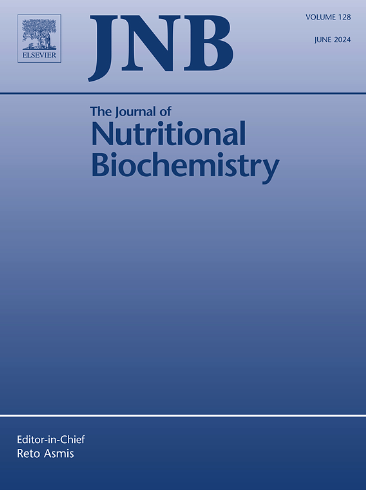EPA but not DHA prevents lipid metabolism disorders by regulating myogenic IL-6 in high-fat fed mice
IF 4.8
2区 医学
Q1 BIOCHEMISTRY & MOLECULAR BIOLOGY
引用次数: 0
Abstract
Lipid metabolism disorder serve as a critical starting point for the development of chronic non-communicable diseases (NCDs). Eicosapentaenoic acid (EPA) and Docosahexaenoic acid (DHA) are known for their lipid-lowering properties, but few studies have revealed their differences from the perspective of skeletal muscle endocrinology. Myogenic IL-6 has garnered significant attention for its role in energy distribution. The primary aim of this study was to investigate the effects and mechanisms of EPA and DHA on myogenic IL-6 and lipid metabolism disorders in mice, and to clarify the association between the alleviation of lipid metabolism disorders and myogenic IL-6 mediated by EPA/DHA. We found that EPA and DHA not only prevented high-fat diet-induced lipid metabolism disorders, but also up-regulated the expression of myogenic IL-6 by activating TRPV1/Ca2+ signaling in skeletal muscle. However, the lipid metabolism prevention effect mediated by EPA was weakened after knockout gene of myogenic IL-6, with its body weight and body fat increased and a large amounts of lipid deposited in the blood, liver, and adipocytes. Meanwhile, there no significantly differences of AMPK/STAT3 signaling in adipose tissue between groups after knockout gene of myogenic IL-6. Based on the results above, we concluded that EPA and DHA can stimulate the production of myogenic IL-6 through TRPV1/Ca2+ signaling in skeletal muscle. The prevention effect of lipid metabolism disorders by EPA, but not DHA, relies on myogenic IL-6, with the underlying mechanism may involving the enhancement of AMPK/STAT3 signaling mediated by myogenic IL-6 in adipose tissues.

EPA而非DHA通过调节肌源性IL-6阻止高脂喂养小鼠脂质代谢紊乱。
脂质代谢紊乱是慢性非传染性疾病发展的一个关键起点。二十碳五烯酸(EPA)和二十二碳六烯酸(DHA)以其降脂特性而闻名,但很少有研究从骨骼肌内分泌学的角度揭示它们的差异。肌源性IL-6因其在能量分布中的作用而受到广泛关注。本研究的主要目的是探讨EPA和DHA对小鼠肌源性IL-6和脂质代谢紊乱的影响及其机制,阐明EPA/DHA介导的脂质代谢紊乱的缓解与肌源性IL-6之间的关系。我们发现EPA和DHA不仅可以预防高脂肪饮食引起的脂质代谢紊乱,还可以通过激活骨骼肌中的TRPV1/Ca2+信号来上调肌源性IL-6的表达。而敲除肌源性IL-6基因后,EPA介导的脂质代谢预防作用减弱,其体重和体脂增加,大量脂质沉积在血液、肝脏和脂肪细胞中。同时,敲除肌源性IL-6基因后,各组脂肪组织AMPK/STAT3信号无显著差异。基于以上结果,我们认为EPA和DHA可以通过骨骼肌中TRPV1/Ca2+信号通路刺激肌源性IL-6的产生。EPA而非DHA对脂质代谢紊乱的预防作用依赖于肌源性IL-6,其潜在机制可能与肌源性IL-6介导的脂肪组织中AMPK/STAT3信号的增强有关。
本文章由计算机程序翻译,如有差异,请以英文原文为准。
求助全文
约1分钟内获得全文
求助全文
来源期刊

Journal of Nutritional Biochemistry
医学-生化与分子生物学
CiteScore
9.50
自引率
3.60%
发文量
237
审稿时长
68 days
期刊介绍:
Devoted to advancements in nutritional sciences, The Journal of Nutritional Biochemistry presents experimental nutrition research as it relates to: biochemistry, molecular biology, toxicology, or physiology.
Rigorous reviews by an international editorial board of distinguished scientists ensure publication of the most current and key research being conducted in nutrition at the cellular, animal and human level. In addition to its monthly features of critical reviews and research articles, The Journal of Nutritional Biochemistry also periodically publishes emerging issues, experimental methods, and other types of articles.
 求助内容:
求助内容: 应助结果提醒方式:
应助结果提醒方式:


